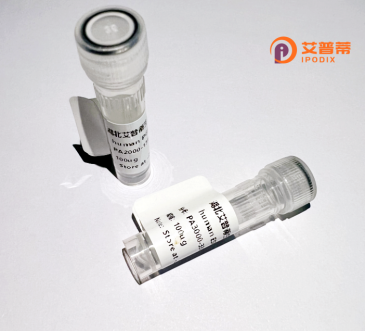
| 纯度 | >90%SDS-PAGE. |
| 种属 | Human |
| 靶点 | PLD1 |
| Uniprot No | P14314 |
| 内毒素 | < 0.01EU/μg |
| 表达宿主 | E.coli |
| 表达区间 | 15-302 aa |
| 活性数据 | VEVKRPRGVSLTNHHFYDESKPFTCLDGSATIPFDQVNDDYCDCKDGSDEPGTAACPNGSFHCTNTGYKPLYIPSNRVNDGVCDCCDGTDEYNSGVICENTCKEKGRKERESLQQMAEVTREGFRLKKILIEDWKKAREEKQKKLIELQAGKKSLEDQVEMLRTVKEEAEKPEREAKEQHQKLWEEQLAAAKAQQEQELAADAFKELDDDMDGTVSVTELQTHPELDTDGDGALSEAEAQALLSGDTQTDATSFYDRVWAAIRDKYRSEALPTDLPAPSAPDLTEPKE |
| 分子量 | 59.3 kDa |
| 蛋白标签 | His tag N-Terminus |
| 缓冲液 | PBS, pH7.4, containing 0.01% SKL, 1mM DTT, 5% Trehalose and Proclin300. |
| 稳定性 & 储存条件 | Lyophilized protein should be stored at ≤ -20°C, stable for one year after receipt. Reconstituted protein solution can be stored at 2-8°C for 2-7 days. Aliquots of reconstituted samples are stable at ≤ -20°C for 3 months. |
| 复溶 | Always centrifuge tubes before opening.Do not mix by vortex or pipetting. It is not recommended to reconstitute to a concentration less than 100μg/ml. Dissolve the lyophilized protein in distilled water. Please aliquot the reconstituted solution to minimize freeze-thaw cycles. |
以下是关于重组人磷脂酶D1(PLD1)蛋白的参考文献示例:
1. **"Cloning and Characterization of Human Phospholipase D1 (PLD1)"**
- 作者:Scott, S.A. 等
- 摘要:研究报道了人源PLD1的克隆及重组表达,并系统分析了其体外酶活性,揭示了钙离子和磷酸肌醇对其活性的调控机制。
2. **"PLD1 Promotes Tumor Metastasis by Regulating Cell Invasion and Migration"**
- 作者:Shen, Y. 等
- 摘要:通过重组PLD1蛋白实验,验证了其在癌症细胞侵袭中的关键作用,证明PLD1通过调控细胞骨架重塑促进肿瘤转移。
3. **"Structural Insights into the Catalytic Mechanism of PLD1"**
- 作者:Leiros, I. 等
- 摘要:利用重组PLD1蛋白进行X射线晶体学分析,解析了其催化结构域的三维结构,阐明了底物识别及水解反应的分子机制。
4. **"Development of PLD1-Specific Inhibitors via High-Throughput Screening"**
- 作者:Brown, H.A. 等
- 摘要:基于重组PLD1蛋白的活性检测平台,筛选出新型小分子抑制剂,为治疗PLD1过表达相关疾病提供潜在策略。
注:上述文献信息为概括性示例,实际引用时请根据具体论文内容调整。
Phospholipase D1 (PLD1) is a member of the phospholipase D enzyme family, which catalyzes the hydrolysis of phosphatidylcholine to generate phosphatidic acid (PA) and choline. PA acts as a critical lipid secondary messenger, regulating diverse cellular processes, including vesicular trafficking, cytoskeletal reorganization, cell proliferation, and survival. PLD1 is primarily localized to intracellular membranes, such as the Golgi apparatus and endosomes, and its activity is tightly controlled by various signaling pathways involving small GTPases, protein kinase C, and receptor tyrosine kinases. Dysregulation of PLD1 has been implicated in multiple pathologies, including cancer, neurodegenerative diseases, and immune disorders, due to its role in promoting cell migration, invasion, and resistance to apoptosis.
Recombinant human PLD1 protein is produced using heterologous expression systems, such as insect or mammalian cells, to ensure proper post-translational modifications and functional activity. Its production enables detailed biochemical studies, such as enzyme kinetics, substrate specificity, and inhibitor screening. Researchers utilize recombinant PLD1 to explore its molecular interactions, structural features, and regulatory mechanisms, providing insights into therapeutic targeting. For instance, PLD1 inhibitors are being investigated for their potential to suppress tumor growth or modulate inflammatory responses. The availability of recombinant PLD1 also facilitates high-throughput assays in drug discovery and the development of diagnostic tools for PLD1-associated diseases, highlighting its importance in both basic research and translational applications.
×